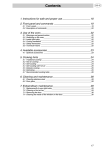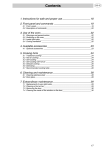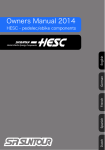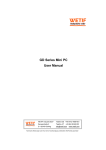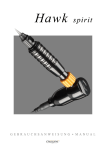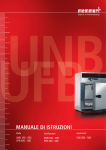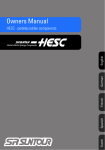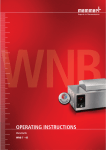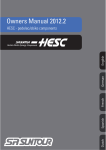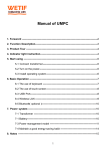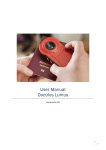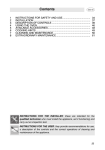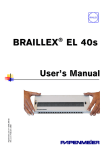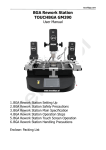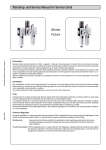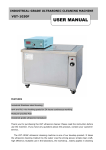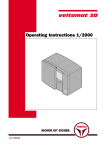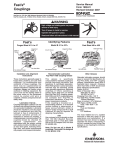Download - Frank`s Hospital Workshop
Transcript
OPERATING INSTRUCTIONS for vertical sterilizer K S G 40/60-2 K S G 50/70-2 K S G 50/80-2 - double-walled execution without sterilization timer and contact thermometer only for for sterilization of unwrapped and not porous hospital utensils as instruments, glas and plastic goods Modifications reserved. 62XEXMXX.XXX Serial-No.: Wiring diagram Piping diagram 16.02.06 01E040602E001 1417-2 D:\e\VERT2\62XEXMXX.XXX\40-60-2-ED - 62xexmxxxxx.PDF KSG Sterilisatoren GmbH Buchhoferstraße 5 82140 Olching Federal Republic of Germany Phone: +49-(0)8142 / 2957-0 Fax: +49-(0)8142 / 40384 E-mail: [email protected] 1 Contents 1. Description ............................................................................. 4 Intended use of the unit Intended aim 5 5 2. Installation .............................................................................. 6 3. Technical Data........................................................................ 7 4. General Remarks.................................................................... 8 5. Operating Instructions ........................................................... 9 Control of feeding water Preparations for further sterilizations Switching off of sterilizer 6. Programme "A1" 121°C - (jacket pressure 1,2 bar)............ 13 Adjustment Loading of the sterilizer Close sterilizing lid Sterilization (121°C) End of programme Open the sterilizer lid Removal of sterile goods Preparations for further sterilizations Switching off of sterilizer 7. 9 12 12 13 13 13 14 15 15 15 16 16 Programme "A2" 121°C - (jacket pressure 2,4 bar)............ 17 Adjustment Loading of the sterilizer Close sterilizing lid Heating-up time Sterilization End of programme Open the sterilizer lid Removal of sterile goods Preparations for further sterilizations Switching off of sterilizer D:\e\VERT2\62XEXMXX.XXX\40-60-2-ED - 62xexmxxxxx.PDF 17 17 18 18 19 20 20 20 21 21 2 8. Programme "B" 134°C - (jacket pressure 2,4 bar).............. 22 Adjustment Loading of the sterilizer Close sterilizing lid Sterilization (134°C) End of programme Open the sterilizer lid Removal of sterile goods Preparations for further sterilizations Switching off of sterilizer 9. 22 22 22 23 24 24 24 25 25 Savety Devices .................................................................... 26 Water shortage in the outer chamber Function safety valve Sterilizer lid Overpressure safety device Table 26 26 26 26 27 10. Maintenance of Sterilizer ..................................................... 28 11. Sterilizer gasket.................................................................... 28 12. Search for Errors.................................................................. 29 13. Short Operating Instruktions............................................... 30 14. Legend .................................................................................. 31 D:\e\VERT2\62XEXMXX.XXX\40-60-2-ED - 62xexmxxxxx.PDF 3 1. Description Name and address of manufacturer: KSG Sterilisatoren GmbH Buchhoferstraße 5 D-82140 Olching Tel: Fax: E-Mail Order-No. XXXXXX Aukl-No. Aukl 002 067 Apparatus No: XXXX Year of construction: XXXX 08142/29 57 0 08142/40 38 4 [email protected] Operator Full mark of steam sterilizer: KSG 40/60-2 double-walled electrically heated Aukl 002 067 KSG 50/70-2 double-walled electrically heated Aukl 002 069 KSG 50/80-2 double-walled electrically heated Aukl 002 077 D:\e\VERT2\62XEXMXX.XXX\40-60-2-ED - 62xexmxxxxx.PDF 4 Intended use of the unit This execution of sterilizer can only be used for sterilization of unwrapped, non-porous solid goods like instruments, glass, rubber and plastic at a sterilization temperature of 134° C or 121° C. As the sterilizer works according to the principle of gravitation no porous goods (i.e. textiles), no hollow bodies (i.e. tubes, pipes) and no wrapped goods (i.e. in shrink or paper foil, in fabrics or cassettes) can be sterilized. Hollow receptacles may preferably be sterilized opening downward. Solutions, independent from the size of the receptacles, may not be sterilized in this sterilizer. In no case inflammable materials may be sterilized. No living beings may be sterilized. The device is not been suitable for the sterilisation (destruction) by the lab goods which were submitted to a chemical and / or biological treatment. Such treated goods may not be sterilized. Intended aim The aim of sterilization is the achievement of the sterility of a sterilizer load (charge) acc. to the sterilizing process. Hint: Sterile is the condition of a (medical) product, which is free from active micro organisms (EN 556). D:\e\VERT2\62XEXMXX.XXX\40-60-2-ED - 62xexmxxxxx.PDF 5 2. Installation 2.1 Before setting into operation please read the operating instructions thoroughly. 2.2 Take care for correct current supply (see type plate). 2.3 Take care for electrical connection, which corresponds to the prescriptions valid on site. 2.4 Attention: 2.5 Prepare cold water connection with a locally installed hand valve for cooling of steam. 2.6 Take care that under the sterilizer there is a water outlet (e.g. gully) for the waste pipes of the sterilizer. 2.7 To guarantee the stability of the sterilizer, the apparatus feeet (32) have to be fixed to the ground. 2.8 If the sterilizer is not used, close the local hand valve for the cold water. Install main switch on site. D:\e\VERT2\62XEXMXX.XXX\40-60-2-ED - 62xexmxxxxx.PDF 6 3. Technical Data Typ Chamber Diameter Chamber Height Chamber Volume Current Capacity: 40/60-2 40 cm 60 cm 075 dm 50/70-2 50 cm 70 cm 137 dm 50/80-2 50 cm 80 cm 157 dm 3 14,5 A 3 3 Operating pressure pe : 2,5 bar Operating temperature: 134° C Nominal voltage: 230/400 V Current: Alternating current Nominal frequency: 50/60 cs D:\e\VERT2\62XEXMXX.XXX\40-60-2-ED - 62xexmxxxxx.PDF Operating water to NW Operating water NW to HW 9,5 kW 25 Liters 16 Liters 19,0 A 12,5 kW 42 Liters 21 Liters 19,0 A 12,5 kW 40 Liters 18 Liters 7 4. General Remarks Feeding water: For operation of the sterilizer either destilled, demineralized or completely desalted water is necessary. Indications concerning the filling quantity of operating water for steam jacket in case of empty chamber until min. water level (NW) up to max. level (HW) can be taken from paragraph 2. Technical data. Two radiators (10). Water shortage sensor (11) with micro heating element 0,5 kW and water shortage protected switch (11a), resettable. Regulator and adjustor for steam jacket pressure (21), max. 2,5 bar. D:\e\VERT2\62XEXMXX.XXX\40-60-2-ED - 62xexmxxxxx.PDF 8 5. Operating Instructions For setting the sterilizer into operation, please proceed as follows: Control of feeding water Level of feeding water (destilled or demineralized water) at the water level glass (6) has to be between the markings for minimum and maximum water level. Should this not be the case, the outer chamber (2) has to be filled with a corresponding quantity of water. This can only be done when the outer chamber (2) is without pressure resp. cold, i.e. the pressure gauge (20)for the steam jacket (2) indicates "0" bar. 5.1.1. Filling in of jacket water for first filling or after having emptied the jacket completely or in case of cold, pressureless outer chamber Open the sterilization valve (9). Open the function safety valve (23) by means of the operating lever (24), if the sterilizer lid (3) is closed. Open the filling valve (5). Fill in destilled or demineralized water into the filling funnel (4) until water level (6) has reached the maximum marking. Close the filling valve (5). Close the sterilization valve (9). D:\e\VERT2\62XEXMXX.XXX\40-60-2-ED - 62xexmxxxxx.PDF 9 5.1.2. Filling in of jacket water when the minimum marking is reached and the jacket is heated up and under pressure between two sterilizing processes. The filling of jacket water can only be executed when the outer chamber (2) is without pressure. If you observe that the water level has reached the minimum marking, the outer chamber (2) must be put into pressureless condition before filling jacket water into the jacket. The outer chamber (2) becomes pressureless by self-radiation, e.g. by switching off the sterilizer at the on/off switch (13), so that the heating elements (10) are switched off. If the sterilizer lid (3) is orderly closed you can additionally open the sterilization valve (9) and the release valve for chamber pressure (25) carefully by simultaneous opening of the inlet valve for the cold water (29), so that a rapid pressure reduction of the jacket (2) via the sterilizing chamber (1) is reached. Open the sterilization valve (9). Thus steam streams out of the jacket (2) into the sterilizing chamber (1). Open carefully the reduction valve for chamber pressure (25). Now steam escapes to the drain. Afterwards open the cold water valve (29) correspondingly, so that the escaping steam is cooled before entering the drain. When the pressure of the outer chamber (2) is "0" bar - pointer of pressure gauge (20) for the outer jacket must indicate "0" - you open the function safety valve (23) with the operation levers (24). Afterwards close the filling valve (5) and fill in distilled and demineralized water in the filling funnel (4), until the water level has reached max. marking. After the end of the filling process close the valves (5), (9), (25) and (29). When you have reset the unit into operation by actuation of the on/off-switch (13), the adjusted steam pressure is produced in the outer jacket. D:\e\VERT2\62XEXMXX.XXX\40-60-2-ED - 62xexmxxxxx.PDF 10 5.1.3. Filling in of jacket water when the min. marking has been passed, the outer chamber (2) is heated up and under pressure and the water shortage protection switch (11a) has reacted. The filling of jacket water can only be executed when the outer chamber (2) is without pressure. If the red controll lamp "water shortage" is illuminated at the electric switch board (12), the water level in the steam jacket has fallen below the admissible value during operation. Before filling the water into the outer chamber, it must be put into a pressureless condition. The outer chamber becomes pressureless by self-radiation, e.g.by switching off the sterilizer at the on/off-switch (13), so that the heating elements (10) are switched off. If the sterilizer lid is orderly closed you can additionally open the sterilization valve (9) and the release valve for chamber pressure (25) carefully by simultaneous opening of the inlet valve for cold water, so that a rapid pressure reduction of the jacket (2) via the sterilizing chamber (1) is reached Open the sterilization valve (9). Thus steam streams out of the jacket (2) into the sterilizing chamber (1). Open carefully the reduction valve for chamber pressure (25). Afterwards open the cold water valve (29) correspondingly, so that the escaping steam is cooled before entering the drain. When the pressure of the outer chamber (2) is "0 bar" - the pointer of the pressure gauge (20) for the outer jacket (2) indicates "0" - you open the function safety valve (23) with the operation levers (24). Afterwards close the filling valve (5) and fill in distilled and demineralized water in the filling funnel (4), until the water level has reached max. marking. After the end of the filling process close the valves (5), (9), (25), (29) and the function safety valve (23) by putting the operating lever (24) from horizontal to vertical pos. Afterwards the water shortage protection switch (11a) has to be set into operation by pressing the reset button, which is situated behind the protection cover at the front side of the water shortage protection switch (11a). The red controll lamp "water shortage" (17) goes out. After having actuated the reset button, the heating elements are switched on again and the steam pressure adjusted at the regulator for sterilizing pressure (21) is produced in the outer jacket. The sterilizing process interrupted by the water shortage must be repeated, as the goods have to be considered as "not sterile". D:\e\VERT2\62XEXMXX.XXX\40-60-2-ED - 62xexmxxxxx.PDF 11 Preparations for further sterilizations When a sterilization has been ended by quick pressure reduction, the sterilizer can quickly be prepared for the next charge, as the steam pressure in the outer jacket (2) is maintained. Controll the water level at the water level indication (6) and add water, if necessary. Switching off of sterilizer For final switching off of the sterilizer, e.g. after the last load of the day, the ON/OFF switch (13) has to be switched off (light goes out) and the inlet valve for cold water (29) has to be closed. D:\e\VERT2\62XEXMXX.XXX\40-60-2-ED - 62xexmxxxxx.PDF 12 6. Programme "A1" 121°C - (jacket pressure 1,2 bar) Adjustment 6.1.1. The saturated steam necessary for sterilization is produced in the steam jacket (2) by means of two electric radiators (10). To start the heating process, please proceed as follows: 6.1.2. Control the water level at the water level indication (6) and add water, if necessary. 6.1.3. Control that filling valve (5) and sterilization valve (9) are closed. 6.1.4. Adjust the sterilizing pressure on the adjusting device (21) as shown in table 9.5, so that the working pressure (jacket pressure) is approx. 0,1-0,2 bar higher than the required pressure (1,2 bar). 6.1.5. Press ON/OFF switch (13) to "ON"-position (control lamp lights green) to start the jacket heating procedure. Now the initiated heating process lasts approx. 20 min., when there is maxium water level and maximum required pressure (approx. 1,2 bar), until the necessary steam pressure is reached. As long as the operating pressure is not reached, heating is in operation. This can be seen by the lighting of the yellow control lamp "heating" (16). The process of jacket preheating is finished when the pressure gauge for the steam jacket (20) indicates the pressure preselected on the adjusting device for sterilizing pressure and the yellow control lamp "heating" (16) goes out for the first time. Now the jacket is ready for sterilization. Loading of the sterilizer 6.2.1. Please classify the sterilizing goods acc. to sterilizing temperature and time (see table 9.5). 6.2.2. If necessary/scheduled, put the sterilizing goods into the provided baskets (accessories). 6.2.3. Place the sterilizing goods into the sterilizing chamber (1) and put them on the ground plate resp. on the trays (accessories). The chamber can be filled up until its upper edge. Close sterilizing lid To that end turn the lid by the operating handles (3a) counter-clockwise until the limit stop and fix it in this axial position. Then tilt the lid downwards until it lies on the gasket (33). Afterwards please turn the lid by means of the operating handles (3a) in clockwise direction until the limit stop (observation of sterilizer lid from the top). At last close the function safety valve (23) with the operating lever (24). This process is executed properly when the lever (24) is situated in the intended groove of the link of the operating handle. Attention: Only by this procedure it is secured that the chamber lid and the function safety valve are closed orderly and pressure in the sterilizing chamber can be produced after opening the sterilization valve. D:\e\VERT2\62XEXMXX.XXX\40-60-2-ED - 62xexmxxxxx.PDF 13 Sterilization (121°C) 6.4.1. Before the sterilizing process controll the adjustment of the adjusting device for sterilizing pressure (21). Compare the pressure of the outer chamber at the pressure gauge (20) for the jacket (2) when the controll lamp (16) "Heating" has gone out with the adjusted value acc. to table 9.5 for the goods to be sterilized and readjust the device (21), if necessary. 6.4.2. Controll the reducing valve for chamber pressure (25) for the sterilizing chamber (1) and close it, if still open. 6.4.3. If the operating pressure necessary for sterilization is reached in the outer chamber (to be seen at the pressure gauge (20) for the steam jacket (2)) open the sterilization valve (9). Now the heatingup time starts. Steam is streaming from the outer chamber (2) into the sterilizing chamber (1). This can be observed at the pressure gauge (19) for the sterilizing chamber. Simultaneously the temperature for the sterilizing chamber is also increasing (to be seen at the pointer thermometer (34) for the sterilizing chamber). Remark a) When steam flows from steam jacket (2) into sterilizing chamber (1), the pressure in the outer chamber decreases - to be seen at the pressure gauge (20) for the outer chamber. Via the adjusting device for sterilizing pressure (21) the radiators are switched on automatically - to be seen on the yellow control lamp "heating" (16). b) The air in the sterilizing chamber is displaced by the entering steam and is led off via the automatic aerator and deaerator (26). At a temperature of 100° C and higher, this component is closed, thus rendering possible that the steam pressure of the sterilizing chamber is reduced. Attention: The sterilizer lid (3) is hot during operation ! 6.4.4. When the indication of both pressure gauges (19 and 20) is identical, i.e. the pressure in the sterilizing chamber corresponds to the pressure adjusted acc. to table 9.5 - the same refers to the temperature - the sterilizing time can be measured. 6.4.5. It is the task of the operating personal to secure (by a suitable timer) that the goods to be sterilized are subject to the sterilizing temperture for the complete time adjusted acc. to table 9.5. For controlling the actual temperature, use the pointer thermometer (34). 6.4.6. When the temperature is lower than the adjusted temperature the measurement of the sterilizing time has to be stopped and can only be continued when the sterilizing temperature is reached again. D:\e\VERT2\62XEXMXX.XXX\40-60-2-ED - 62xexmxxxxx.PDF 14 End of programme 6.5.1. After the end of the sterilizing time the sterilizing process must be ended. The sterile goods can be removed after pressure reduction in the sterilizing chamber. This pressure reduction can be reached by different methods, acc. to requirements (see table 9.5): 6.5.2. By self-radiation of the complete sterilizer, i.e. the unit is switched off at the on/off-switch, thus switching off the electrical heating. After the self-radiation the sterilizing valve (9) must be closed again. 6.5.3. By quick reduction of the pressure from the sterilizing chamber (1). First you close the sterilizing valve (9) and afterwards you open the release valve for chamber pressure (25) carefully. In order that the escaping steam is cooled down before entering the drain, open the cold water valve (29), so that a temperature of max. 50°C is reached. This procedure is continued until the pressure of the chamber (1) is "0" bar (to be seen at the pressure gauge (19) for the sterillizing chamber). The closing of the sterilizing valve (9) has the effect that the steam flow between outer chamber (2) and sterilizing chamber (1) is interrupted. The separation of both chambers (1 and 2) allows that the sterile goods can be removed from the sterilizing chamber, while the operating pressure in the outer chamber is maintained for further operation. Open the sterilizer lid 6.6.1. After pressure reduction (indication "0" bar at the pressure gauge (19) for the sterilizing chamber) the sterilizer lid (3) may be opened and the sterile goods be removed, if the temperature has decreased to approx. 60°C (to be seen at the pointer thermometer). 6.6.2. For that purpose the function safety valve (23) is opened with the operation lever (24) - operation lever (24) must be brought to the right side in its horizontal limit position. The eventually remaining overpressure now escapes via the exhaust tube of the function safety valve (23). Attention: It is still possible that steam escapes at the exhaust tube of this valve. By means of the operation handles (3a) the lid (3) is turned in clockwise direction until the limit stop (seen from the top) and then opened. Removal of sterile goods Now the - possibly still hot - sterile goods can be removed. Attention: It is still possible that steam escapes from the sterilizing chamber. D:\e\VERT2\62XEXMXX.XXX\40-60-2-ED - 62xexmxxxxx.PDF 15 Preparations for further sterilizations When a sterilization has been ended by quick pressure reduction, the sterilizer can quickly be prepared for the next charge, as the steam pressure in the outer jacket (2) is maintained. Controll the water level at the water level indication (6) and add water, if necessary. Switching off of sterilizer For final switching off of the sterilizer, e.g. after the last load of the day, the ON/OFF switch (13) has to be switched off (light goes out) and the inlet valve for cold water (29) has to be closed. D:\e\VERT2\62XEXMXX.XXX\40-60-2-ED - 62xexmxxxxx.PDF 16 7. Programme "A2" 121°C - (jacket pressure 2,4 bar) Adjustment With max. jacket pressure adjustment (2,4 bar) 7.1.1. The saturated steam necessary for sterilization is produced in the steam jacket (2) by means of two electric radiators (10). To start the heating process, please proceed as follows: 7.1.2. Control the water level at the water level indication (6) and add water, if necessary. 7.1.3. Control that filling valve (5) and sterilization valve (9) are closed. 7.1.4. Adjust the sterilizing pressure on the adjusting device (21) as shown in table 9.5, so that the working pressure is approx. 0,1-0,2 bar higher then the required pressure (2,4 bar). 7.1.5. Press ON/OFF switch (13) to "ON"-position (control lamp lights green) to start the jacket heating procedure. Now the initiated heating process lasts approx. 30 min., when there is maximum water level and maximum required pressure (approx. 2,4 bar), until the necessary steam pressure is reached. As long as the operating pressure is not reached, heating is in operation. This can be seen by the lighting of the yellow control lamp "heating" (16). The process of jacket preheating is finished when the pressure gauge for the steam jacket (20) indicates the pressure preselected on the adjusting device for sterilizing pressure and the yellow control lamp "heating" (16) goes out for the first time. Now the jacket is ready for sterilization. Loading of the sterilizer 7.2.1. Please classify the sterilizing goods acc. to sterilizing temperature and time (see table 9.5). 7.2.2. If necessary/scheduled, put the sterilizing goods into the provided baskets (accessories). 7.2.3. Place the sterilizing goods into the sterilizing chamber (1) and put them on the ground plate resp. on the trays (accessories). The chamber can be filled up until its upper edge. Remark: When selecting the goods to be sterilized and the arrangement in the chamber please take into consideration that during the process described above the radiation temperature (approx. 134°C) of the outer jacket (2) is much higher than the real sterilizing temperature (approx. 124°C) in the sterilizing chamber (1). Take care that the sterile goods doe not contact the walls of the chamber. D:\e\VERT2\62XEXMXX.XXX\40-60-2-ED - 62xexmxxxxx.PDF 17 Close sterilizing lid To that end turn the lid by the operating handles (3a) counter-clockwise until the limit stop and fix it in this axial position. Then tilt the lid downwards until it lies on the gasket (33). Afterwards please turn the lid by means of the operating handles (3a) in clockwise direction until the limit stop (observation of sterilizer lid from the top). At last close the function safety valve (23) with the operating lever (24). This process is executed properly when the lever (24) is situated in the intended groove of the link of the operating handle. Attention: Only by this procedure it is secured that the chamber lid and the function safety valve are closed orderly and pressure in the sterilizing chamber can be produced after opening the sterilization valve. Heating-up time At this sterilizing method you can start the sterilizing process, when the pressure in the outer chamber (2) is higher than the pressure necessary for sterilization. 7.4.1. To initiate the heating-up time, open the sterilizing valve (9) carefully. Now the steam is streaming from the outer jacket into the sterilizing chamber. 7.4.2. Observe the pointer of the pressure gauge (19) for the sterilizing chamber (1). When it has reached approx. 1,2 - 1,3 bar, close the sterilizing valve. Open it again, when the pointer has dropped down to approx. 1,1 bar to close it again when the pointer has reached approx. 1,2 - 1,3 bar. 7.4.3. From the movement of this pointer in the thermometer (34) for the sterilizing chamber (1) you can see the temperature increase in the sterilizing chamber. 7.4.4. By the opening and closing of the sterilizing valve (9) - as described above - a constant chamber temperature of approx. 121°C - 124°C should be reached. 7.4.5. The heating up time is ended when the pointer of the thermometer (34) has reached the sterilizing temperature. D:\e\VERT2\62XEXMXX.XXX\40-60-2-ED - 62xexmxxxxx.PDF 18 Sterilization 7.5.1. The process during programme step "Sterilization" is the same as for programme step "Heating up", i.e. the operator maintains the chamber temperature while observing the pressure gauge (19) and the thermometer (34) by opening and closing of the sterilizing valve (9) between 121°C and 124°C. 7.5.2. It is the task of the operating personal to secure by a suitable timer that the sterile goods are subject to the sterilizing temperature for the complete time adjusted acc. to table 9.5. For controlling the actual temperature the operating personal uses the thermometer (34). 7.5.3. Measurement of the time can be started when the pointer of the thermometer (34) has reached a chamber temperature of min. 121°C. It must be interrupted when the temperature is below 121°C and can be started again after having reached this temperature. Attention: When the temperature has sunk below the adjusted value, the sterilizing timer has to be stopped and only be continued after having reached the temperature again. D:\e\VERT2\62XEXMXX.XXX\40-60-2-ED - 62xexmxxxxx.PDF 19 End of programme 7.6.1. After the end of the sterilizing time the sterilizing process must be ended. The sterile goods can be removed after pressure reduction in the sterilizing chamber. This pressure reduction can be reached by different methods, acc. to requirements (see table 9.5): 7.6.2. By self-radiation of the complete sterilizer, i.e. the unit is switched off at the on/off-switch, thus switching off the electrical heating. After the self-radiation the sterilizing valve (9) must be closed again. 7.6.3. By quick reduction of the pressure from the sterilizing chamber (1). First you close the sterilizing valve (9) and afterwards you open the release valve for chamber pressure (25) carefully. In order that the escaping steam is cooled down before entering the drain, open the cold water valve (29), so that a temperature of max. 50°C is reached. This procedure is continued until the pressure of the chamber (1) is "0" bar (to be seen at the pressure gauge (19) for the sterilizing chamber). 7.6.4. The closing of the sterilizing valve (9) has the effect that the steam flow between outer chamber (2) and sterilizing chamber (1) is interrupted. The separation of both chambers (1 and 2) allows that the sterile goods can be removed from the sterilizing chamber, while the operating pressure in the outer chamber is maintained for further operation. Open the sterilizer lid 7.7.1. After pressure reduction (indication "0" bar at the pressure gauge (19) for the sterilizing chamber) the sterilizer lid (3) may be opened and the sterile goods be removed, if the temperature has decreased to approx. 60°C (to be seen at the pointer thermometer). 7.7.2. For that purpose the function safety valve (23) is opened with the operation lever (24) - operation lever (24) must be brought to the right side in its horizontal limit position. The eventually remaining overpressure now escapes via the exhaust tube of the function safety valve (23). Attention: It is still possible that steam escapes at the exhaust tube of this valve. By means of the operation handles (3a) the lid (3) is turned in clockwise direction until the limit stop (seen from the top) and then opened. Removal of sterile goods Now the - possibly still hot - sterile goods can be removed. Attention: It is still possible that steam escapes from the sterilizing chamber. D:\e\VERT2\62XEXMXX.XXX\40-60-2-ED - 62xexmxxxxx.PDF 20 Preparations for further sterilizations When a sterilization has been ended by quick pressure reduction, the sterilizer can quickly be prepared for the next charge, as the steam pressure in the outer jacket (2) is maintained. Control the water level at the water level indication (6) and add water, if necessary. Switching off of sterilizer For final switching off of the sterilizer, e.g. after the last load of the day, the ON/OFF switch (13) has to be switched off (light goes out) and the inlet valve for cold water (29) has to be closed. Remark: When selecting the goods to be sterilized and the arrangement in the chamber please take into consideration that during the process described above the radiation temperature (approx. 134°C) of the outer jacket (2) is much higher than the real sterilizing temperature (approx. 124°C) in the sterilizing chamber (1). Take care that the sterile goods doe not contact the walls of the chamber. D:\e\VERT2\62XEXMXX.XXX\40-60-2-ED - 62xexmxxxxx.PDF 21 8. Programme "B" 134°C - (jacket pressure 2,4 bar) Adjustment 8.1.1. The saturated steam necessary for sterilization is produced in the steam jacket (2) by means of two electric radiators (10). To start the heating process, please proceed as follows: 8.1.2. Control the water level at the water level indication (6) and add water, if necessary. 8.1.3. Control that filling valve (5) and sterilization valve (9) are closed. 8.1.4. Adjust the sterilizing pressure on the adjusting device (21) as shown in table 9.5, so that the working pressure is approx. 0,1-0,2 bar higher then the required pressure (2,4 bar). 8.1.5. Press ON/OFF switch (13) to "ON"-position (control lamp lights green) to start the jacket heating procedure. Now the initiated heating process lasts approx. 30 min., when there is maximum water level and maximum required pressure (approx. 2,4 bar), until the necessary steam pressure is reached. As long as the operating pressure is not reached, heating is in operation. This can be seen by the lighting of the yellow control lamp "heating" (16). The process of jacket preheating is finished when the pressure gauge for the steam jacket (20) indicates the pressure preselected on the adjusting device for sterilizing pressure and the yellow control lamp "heating" (16) goes out for the first time. Now the jacket is ready for sterilization. Loading of the sterilizer 8.2.1. Please classify the sterilizing goods acc. to sterilizing temperature and time (see table 9.5). 8.2.2. If necessary/scheduled, put the sterilizing goods into the provided baskets (accessories). 8.2.3. Place the sterilizing goods into the sterilizing chamber (1) and put them on the ground plate resp. on the trays (accessories). The chamber can be filled up until its upper edge. Close sterilizing lid To that end turn the lid by the operating handles (3a) counter-clockwise until the limit stop and fix it in this axial position. Then tilt the lid downwards until it lies on the gasket (33). Afterwards please turn the lid by means of the operating handles (3a) in clockwise direction until the limit stop (observation of sterilizer lid from the top). At last close the function safety valve (23) with the operating lever (24). This process is executed properly when the lever (24) is situated in the intended groove of the link of the operating handle. Attention: Only by this procedure it is secured that the chamber lid and the function safety valve are closed orderly and pressure in the sterilizing chamber can be produced after opening the sterilization valve. D:\e\VERT2\62XEXMXX.XXX\40-60-2-ED - 62xexmxxxxx.PDF 22 Sterilization (134°C) 8.4.1. Before the sterilizing process control the adjustment of the adjusting device for sterilizing pressure (21). Compare the pressure of the outer chamber at the pressure gauge (20) for the jacket (2) when the control lamp (16) "Heating" has gone out with the adjusted value acc. to table 9.5 for the goods to be sterilized and readjust the device (21), if necessary. 8.4.2. Control the reducing valve for chamber pressure (25) for the sterilizing chamber (1) and close it, if still open. 8.4.3. If the operating pressure necessary for sterilization is reached in the outer chamber (to be seen at the pressure gauge (20) for the steam jacket (2) open the sterilization valve (9)). Now the heatingup time starts. Steam is streaming from the outer chamber (2) into the sterilizing chamber (1). This can be observed at the pressure gauge (19) for the sterilizing chamber. Simultaneously the temperature for the sterilizing chamber is also increasing (to be seen at the pointer thermometer (34) for the sterilizing chamber). Remark a) When steam flows from steam jacket (2) into sterilizing chamber (1), the pressure in the outer chamber decreases - to be seen at the pressure gauge (20) for the outer chamber. Via the adjusting device for sterilizing pressure (21) the radiators are switched on automatically - to be seen on the yellow control lamp "heating" (16). b) The air in the sterilizing chamber is displaced by the entering steam and is led off via the automatic aerator and deaerator (26). At a temperature of 100° C and higher, this component is closed, thus rendering possible that the steam pressure of the sterilizing chamber is reduced. Attention: The sterilizer lid (3) is hot during operation ! 8.4.4. When the indication of both pressure gauges (19 and 20) is identical, i.e. the pressure in the sterilizing chamber corresponds to the pressure adjusted acc. to table 9.5 - the same refers to the temperature - the sterilizing time can be measured. 8.4.5. It is the task of the operating personal to secure (by a suitable timer) that the goods to be sterilized are subject to the sterilizing temperture for the complete time adjusted acc. to table 9.5. For controlling the actual temperature, use the pointer thermometer (34). 8.4.6. When the temperature is lower than the adjusted temperature the measurement of the sterilizing time has to be stopped and can only be continued when the sterilizing temperature is reached again. D:\e\VERT2\62XEXMXX.XXX\40-60-2-ED - 62xexmxxxxx.PDF 23 End of programme 8.5.1. After the end of the sterilizing time the sterilizing process must be ended. The sterile goods can be removed after pressure reduction in the sterilizing chamber. This pressure reduction can be reached by different methods, acc. to requirements (see table 9.5): 8.5.2. By self-radiation of the complete sterilizer, i.e. the unit is switched off at the on/off-switch, thus switching off the electrical heating. After the self-radiation the sterilizing valve (9) must be closed again. 8.5.3. By quick reduction of the pressure from the sterilizing chamber (1). First you close the sterilizing valve (9) and afterwards you open the release valve for chamber pressure (25) carefully. In order that the escaping steam is cooled down before entering the drain, open the cold water valve (29), so that a temperature of max. 50°C is reached. This procedure is continued until the pressure of the chamber (1) is "0" bar (to be seen at the pressure gauge (19) for the sterilizing chamber). The closing of the sterilizing valve (9) has the effect that the steam flow between outer chamber (2) and sterilizing chamber (1) is interrupted. The separation of both chambers (1 and 2) allows that the sterile goods can be removed from the sterilizing chamber, while the operating pressure in the outer chamber is maintained for further operation. Open the sterilizer lid 8.6.1. After pressure reduction (indication "0" bar at the pressure gauge (19) for the sterilizing chamber) the sterilizer lid (3) may be opened and the sterile goods be removed, if the temperature has decreased to approx. 60°C (to be seen at the pointer thermometer). 8.6.2. For that purpose the function safety valve (23) is opened with the operation lever (24) - operation lever (24) must be brought to the right side in its horizontal limit position. The eventually remaining overpressure now escapes via the exhaust tube of the function safety valve (23). Attention: It is still possible that steam escapes at the exhaust tube of this valve. By means of the operation handles (3a) the lid (3) is turned in clockwise direction until the limit stop (seen from the top) and then opened. Removal of sterile goods Now the - possibly still hot - sterile goods can be removed. Attention: It is still possible that steam escapes from the sterilizing chamber. D:\e\VERT2\62XEXMXX.XXX\40-60-2-ED - 62xexmxxxxx.PDF 24 Preparations for further sterilizations When a sterilization has been ended by quick pressure reduction, the sterilizer can quickly be prepared for the next charge, as the steam pressure in the outer jacket (2) is maintained. Control the water level at the water level indication (6) and add water, if necessary. Switching off of sterilizer For final switching off of the sterilizer, e.g. after the last load of the day, the ON/OFF switch (13) has to be switched off (light goes out) and the inlet valve for cold water (29) has to be closed. D:\e\VERT2\62XEXMXX.XXX\40-60-2-ED - 62xexmxxxxx.PDF 25 9. Savety Devices Water shortage in the outer chamber A sensor (11) is built in above the radiators, so that they cannot burn through in case of extreme shortage of destilled resp. demineralized water. The sensor consists of a small radiator with integrated temperature sensor. In case of water shortage the temperature sensor - heated up by the small radiator - gives a signal to the water shortage protected switch (11a). Via a contactor (10a) this switch durably separates the radiators (10) and the small radiator in the water shortage sensor (11) from electric mains. At the same time the red control lamp "water shortage" (17) lights up. When the water shortage has been removed by refilling of water, the reset button has to be pressed at the water shortage protection switch. Thus the red lamp (17) "water shortage" extinguishes. Sterilization can be started again. Function safety valve When the sterilizer lid is orderly closed, this valve (23) prevents by its operation lever (24) that the lid can be opened when the sterilizing chamber is under pressure. If anyone tries to open the chamber nevertheless, the lever (24) has to be operated first. This would mean that via the activated valve (23) possibly existing pressure would be reduced and be led away via the exhaust pipe. Sterilizer lid The sterilizer lid is opened and closed by a tongue and groove system. Thus an opening of the lid (3) is not possible, when there is pressure inside. Should the lid be opened - due to an accumulation of misfunctions (depending on the apparatus or on wrong operation) - when there is still a remaining pressure inside the chamber, this inner pressure presses the lid into the mechanical locking position, before it can be opened completely. Due to the arrangement of the tongue and groove system the remaining pressure between chamber and lid can escape, but a dangerous flying open of the lid is surely prevented. Overpressure safety device If the radiators (10) are not switched off due to a failure of the regulator for sterilization pressure (21) and an inadmissible high steam pressure is established in the outer chamber, the safety valve (30) reacts upon an overpressure of more than 2,5 bar. It opens the way outside, removes safely the surplus pressure via a tube, thus preventing dangerous overpressure in the outer chamber. In case of reaction of the safety valve, switch off the apparatus by the ON/OFF switch (13) and examine the apparatus. D:\e\VERT2\62XEXMXX.XXX\40-60-2-ED - 62xexmxxxxx.PDF 26 Table Goods to be sterilized Jacket pressure Sterilizing pressure Sterilizing temperature Sterilizing time Method of cooling A1 Instruments, Glas and Plastic goods 1,3 bar – 1,4 bar 1,2 bar 121° C 30 Min. Quick steam reduction or Self-cooling A2 Instruments, Glas and Plastic goods 2,5 bar – 2,6 bar 1,2 bar 121° C 30 Min. Quick steam reduction or Self-cooling 2,5 bar – 2,6 bar 2,4 bar 134° C 10 Min. Quick steam reduction or Self-cooling Programme B Instruments, Glas Goods which may be sterilized In programme A (1,2 bar / 121° C) only unwrapped solids with a destroy temperature 121° C may be sterilized. In programme A (2,4 bar / 121° C) only unwrapped solids with a destroy temperature 121° C may be sterilized. In programme B (2,4 bar / 134° C) only unwrapped solids, like instruments and other similar utensils, may be sterilized. D:\e\VERT2\62XEXMXX.XXX\40-60-2-ED - 62xexmxxxxx.PDF 27 10. Maintenance of Sterilizer In case of external contamination of unit and inner chamber, clean these parts moistly. When the switchboard is cleaned, separate it first from mains supply. The inner chamber must always be kept clean. If necessary, wash it out, let off the liquid via the emptying valve (25) and rinse. If the water of the outer chamber becomes turbid, - to be seen on the level glass (6) - the water can be let off via the emptying valve (31). In case of calcareous water, the apparatus has to be decalcified once a year. These intervals can be extended when the outer chamber is emptied regularly. 11. Sterilizer gasket In course of time the sterilizer gasket (33) is subject to a natural wear and tear and has to be exchanged, if necessary, e.g. if it is deformed or damaged or if during sterilization steam escapes at the gasket. The gasket has to be greased in regular intervals (with silicone fat or similar). D:\e\VERT2\62XEXMXX.XXX\40-60-2-ED - 62xexmxxxxx.PDF 28 12. Search for Errors Temperature indication does not work -> stream obstructed -> condensate trap defective No pressure in the outer chamber -> no water in the outer chamber -> no current / fuse defective -> water shortage protection disengaged Chamber gasket leaky -> gasket defective -> dirt on the gasket -> gasket has to be greased D:\e\VERT2\62XEXMXX.XXX\40-60-2-ED - 62xexmxxxxx.PDF 29 13. Short Operating Instruktions for vertical autoclave KSG 40/60-2 / 50/70-2 / 50/80-2 without sterilization timer. Filling of the apparatus with distilled water until at last middle of water level indication. Preheat steam jacket up to the adjusted pressure. Fill unit with goods to be sterilized and close the lid. Open sterilization valve (9) and wait until the sterilizing time has run down. Close the sterilization valve (9). Open the reduction valve for chamber pressure (25). Open the cold water inlet valve (29). Close the cold water inlet valve (29), when the chamber (1) is pressureless. Open function safety valve (23), turn the lid into opposite direction and lift it off, if necessary, close reducing valve for chamber pressure (25). D:\e\VERT2\62XEXMXX.XXX\40-60-2-ED - 62xexmxxxxx.PDF 30 14. Legend 1 2 3 3a 4 5 5a 6 7 8 9 10 11 11a 12 13 16 17 19 20 21 23 24 25 26 27 28 28a 29 30 31 32 33 34 Sterilizing chamber Outer chamber / steam jacket Sterilizer lid with swivel bow Operation handles for (3) Filling funnel for distilled/demineralized water Filling valve Flap trap for (5) Water level with protective covering Water level valve, top Water level valve, bottom with drain valve Sterilization valve Plunger-type radiators (2x) Water shortage sensor with micro radiator Water shortage protected switch, resettable Switch box / electric control case ON/OFF switch / main switch Control lamp "heating" (yellow) Control lamp "water shortage" (red) Pressure gauge for sterilizing chamber (1) Pressure gauge for steam jacket (2) Adjusting device for sterilizing pressure with regulation Function safety valve (with exhaust tube) Operating lever for (23) Release valve for chamber pressure (for sterilizing chamber) Automatic aerator and deaerator Return valve Cooler Drain Inlet valve for cooling water Safety valve (with exhaust tube) Emptying valve for (2) Apparatus feet with fixation holes Gasket for (1) / (3) Indicating thermometer for (1) Remark: All valves are in closed position when they are moved clockwise - seen on the operation handle - until the limit stop. D:\e\VERT2\62XEXMXX.XXX\40-60-2-ED - 62xexmxxxxx.PDF 31 3 3a 4 19 5a 21 5 9 23 19 24 20 9 D:\e\VERT2\62XEXMXX.XXX\40-60-2-ED - 62xexmxxxxx.PDF 32 11a 34 26 29 11 28 10 28a D:\e\VERT2\62XEXMXX.XXX\40-60-2-ED - 62xexmxxxxx.PDF 10 33 26 25 28 29 11 34 26 10 25 27 D:\e\VERT2\62XEXMXX.XXX\40-60-2-ED - 62xexmxxxxx.PDF 34 13 16 17 12 30 31 32 D:\e\VERT2\62XEXMXX.XXX\40-60-2-ED - 62xexmxxxxx.PDF 35 7 6 8 1 33 2 D:\e\VERT2\62XEXMXX.XXX\40-60-2-ED - 62xexmxxxxx.PDF 36




































